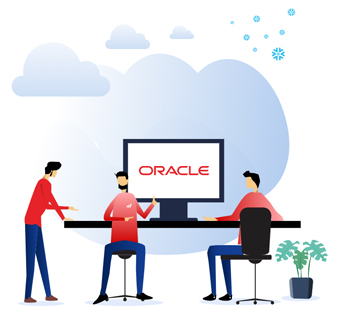Oracle Database Versions & Editions
Oracle database versions and editions define the usage of features, options, and management packs.
On Premise and BYOL Cloud license compliance is version & edition dependent.

Oracle Database History
Sometimes, in managing licensing, knowledge of history of the deployed products is very useful and assumes critical importance. In the case of Oracle this is true of its flagship database products, their middleware suite, the applications suites & quite a few of the products acquired since 2004.
Oracle Database History
The Oracle database is a product that has been developed for the past 40 years with the first commercially available RDBMS released in 1979. Within four years, Oracle released a truly portable RDBMS that could run on mainframes, minicomputers & PCs. This database was written in C allowing porting and support on multiple operating systems & hardware platforms. While Oracle 6 introduced PL/SQL, it was Oracle 7 that made Oracle the ‘king of the database market’. Oracle 7 brought in stored procedures and triggers. Also the scalability and robustness of Oracle 7 made it most useful to be run on lower-cost computers. This ensured data integrity and better return on investments.
Oracle 8i changed the world with its becoming, along with a few other companies, the face of the internet. Oracle 8i provided native internet protocol support and server-side Java.
Since then there have been many more innovations that have helped Oracle remain the largest vendor in the database market. Some of these changes have been enumerated in the tables below.
It is important to note that most of the innovations have repercussions for Oracle database licensing and the cost of ownership.
Importance of Oracle Database Versions and Editions in Licensing
Euladox is an enterprise application for IT operations consisting of very deep IT Asset Management functionality with an equally excellent Incident Management module.
Built modularly with Automated discovery of all IT Assets, Asset CMDB, Software inventory, License Management, Warranty & AMC, Consumables management, Contracts Management & Omni-Channel Incident Management.
Oracle Database Editions
Some of the Oracle database editions available over the years. We have mentioned only those versions that are currently important for managing Oracle license compliance.
| Oracle Database Lite | Oracle Database Express Edition | Oracle Database Personal Edition | Oracle Database Standard Edition | Oracle Database Standard Edition One | Oracle Database Std Edition 2 | Oracle Database Enterprise Edition | |
|---|---|---|---|---|---|---|---|
| Starting Version | Oracle 8i | Oracle 10g | Oracle 7 | Oracle 8i | Oracle 10g | Oracle 12c | Oracle 8 |
| Current Availability | Free | Yes | No | No | Yes | Yes | |
| Platforms | Windows | Windows | Windows | Windows, Unix, Linux | Windows, Unix, Linux | Windows, Unix, Linux | Windows, Unix, Linux |
| Licensing Metrics | Schedule P | Device | Device | Named User Plus, Processor | Named User Plus, Processor | Named User Plus, Processor | Named User Plus, Processor |
| Database Options | No | No | Yes(included in license, except RAC) | Only RAC (included after 10g) | No | Only RAC | Yes (at extra cost) |
| Database Management Packs | No | No | No | No | No | No | Yes (at extra cost) |
| What is the product used for | Schedule P | The schedules are described below, they are co-terminus with the OMA | Oracle – Customer | OMA Schedules | Schedule P | The schedules are described below, they are co-terminus with the OMA | Oracle – Customer |
Oracle Database Versions
The different Oracle versions available over the years:
| Oracle 7 | Oracle 8 | Oracle 8i | Oracle 9i | Oracle 10g | Oracle 11g | Oracle 12c | Oracle 18c | Oracle 19c | |
|---|---|---|---|---|---|---|---|---|---|
| GA Year | 1992 | 1997 | 1998 | 2000 | 2003 | 2007 | 2013 | 2018 | 2019 |
| Banner Versions | 7.1.x 7.3.x |
8.0.x | 8.1.x | 9.0.1.x 9.2.0.x |
10.1.0.x 10.2.0.x |
11.1.0.x 11.2.0.x |
12.1.0.x 12.2.0.1 |
12.2.0.2 | 12.2.0.3 |
| Key Features in Oracle Marketing Material | Universal Server | Oracle on Linux | Java in the database | Oracle Real Application Cluster (RAC) | Grid Database | Columnar Compression | Database for the cloud | Autonomous Database | Cool stuff for DBAs
Terminal 12c release |
| New Features Added Compared to earlier version Schedules | Distributed 2-phase commit, PL/SQL stored procedures, Triggers, Shared Cursors, Cost-Based Optimizer Parallel SQL Execution Transparent Application Failover Object-relational database |
Recovery Manager, Partitioning. First version available for Linux. |
Java and Native internet protocols, Virtual Private Database | Oracle Real Application Clusters (RAC), Oracle XML DB Advanced Queuing, Data Mining, Streams, Logical Standby |
Automated Database Management, Automatic Database Diagnostic Monitor, Grid infrastructure, Oracle ASM, Flashback Database Real Application Testing, Database Vault, Online Indexing, Advanced Compression, Data Guard Fast-Start Failover, Transparent Data Encryption |
Active Data Guard, Secure Files, Edition Based Redefinition, Data Redaction, Hybrid Columnar Compression, Cluster File System, Golden Gate Replication |
Multitenant architecture, In-Memory Column Store, Native JSON, SQL Pattern Matching, Native Sharding, Zero Data Loss Recovery Appliance |
Polymorphic Table Functions, Active Directory Integration |
Active Data Guard DML Redirection, Automatic Index Creation, Real-Time Statistics Maintenance, SQL Queries on Object Stores, In-Memory for IoT Data Streams |
| Brief Licensing Changes | Generally only one edition sold though some customers have noted presence of EE in the banner | Enterprise Edition introduced Partitioning & Management Pack Options introduced |
Concurrent licensing was stopped for this & earlier versions around this time | Processor & Named User Plus metrics only |
Increased Number of Options | Increased Number of Options | Increased Number of Options | Spatial & Graph option included in the database | Number of free PDBs increased to 3 |

